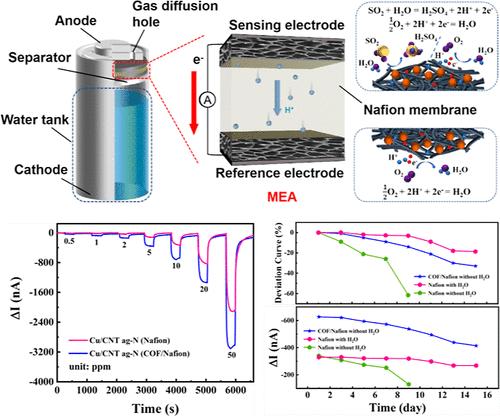Our official English website, www.x-mol.net, welcomes your
feedback! (Note: you will need to create a separate account there.)
Enhancing SO2 Sensing Performance of a Fuel Cell-Type Sensor with N-Doped Cu/CNT Aerogel Electrode and COF/Nafion Electrolyte
ACS Sensors ( IF 8.2 ) Pub Date : 2024-11-07 , DOI: 10.1021/acssensors.4c02253 Lingchu Huang, Huaiyuan Sun, Weijia Li, Jianyu Zhang, Sitong Feng, Qi Lu, Tong Wang, Xishuang Liang, Fangmeng Liu, Fengmin Liu, Geyu Lu
ACS Sensors ( IF 8.2 ) Pub Date : 2024-11-07 , DOI: 10.1021/acssensors.4c02253 Lingchu Huang, Huaiyuan Sun, Weijia Li, Jianyu Zhang, Sitong Feng, Qi Lu, Tong Wang, Xishuang Liang, Fangmeng Liu, Fengmin Liu, Geyu Lu

|
Sulfur dioxide (SO2) is a common environmental pollutant with significant hazards. However, sensors for SO2 real-time monitoring at room temperature often face problems such as a poor response and sluggish recovery. In this work, a fuel cell-type gas sensor based on nitrogen-doped carbon nanotube (CNT) aerogels loaded with Cu particle electrode material and COF/Nafion composite electrolyte was developed, which exhibited excellent SO2 sensitivity and fast response/recovery. The aerogel scaffold provided a high specific surface area and high electrical conductivity, and Cu particles provided good catalytic activity to SO2. In addition, N doping further enhanced the SO2 capture capability and conductivity of the electrode material. For electrolyte construction, covalent organic framework (COF) nanosheets were synthesized by a bottom-up approach and blended with Nafion to prepare the COF/Nafion membrane; the composite membrane showed higher proton conductivity. Owing to these advantages, the fuel cell-type sensor exhibited an outstanding response of −3008.5 nA to 50 ppm of SO2 with a rapid response time (35 s) and recovery time (77 s). Moreover, the rigid nanochannels of COF nanosheets improved the water retention properties of the electrolyte; this will help to simplify the structure of fuel cell-type sensors and provide a significant stimulus for their miniaturization. Based on the great sensing performance, a fuel cell-type SO2 sensor is integrated into a portable detector and evaluated in the context of dynamic environmental monitoring. The results show that the fuel cell-type sensor with the carefully designed electrode and electrolyte will have great potential in environmental monitoring and safety assurance.
中文翻译:

增强采用 N 掺杂 Cu/CNT 气凝胶电极和 COF/Nafion 电解质的燃料电池型传感器的 SO2 传感性能
二氧化硫 (SO2) 是一种常见的环境污染物,具有重大危害。然而,用于室温下 SO2 实时监测的传感器经常面临响应不佳和恢复缓慢等问题。在这项工作中,开发了一种基于氮掺杂碳纳米管 (CNT) 气凝胶的燃料电池型气体传感器,该气凝胶负载了 Cu 颗粒电极材料和 COF/Nafion 复合电解质,表现出优异的 SO2 灵敏度和快速响应/恢复。气凝胶支架提供高比表面积和高导电性,Cu 颗粒为 SO2 提供良好的催化活性。此外,N 掺杂进一步增强了电极材料的 SO2 捕获能力和电导率。对于电解质构建,采用自下而上的方法合成共价有机框架 (COF) 纳米片,并与 Nafion 共混制备 COF/Nafion 膜;复合膜显示出更高的质子电导率。由于这些优势,燃料电池型传感器对 50 ppm 的 SO2 表现出 −3008.5 nA 的出色响应,响应时间短 (35 s) 和恢复时间 (77 s)。此外,COF 纳米片的刚性纳米通道提高了电解质的保水性能;这将有助于简化燃料电池型传感器的结构,并为其小型化提供重要刺激。基于出色的传感性能,燃料电池型 SO2 传感器被集成到便携式探测器中,并在动态环境监测的背景下进行评估。 结果表明,采用精心设计的电极和电解液的燃料电池型传感器在环境监测和安全保障方面具有巨大潜力。
更新日期:2024-11-08
中文翻译:

增强采用 N 掺杂 Cu/CNT 气凝胶电极和 COF/Nafion 电解质的燃料电池型传感器的 SO2 传感性能
二氧化硫 (SO2) 是一种常见的环境污染物,具有重大危害。然而,用于室温下 SO2 实时监测的传感器经常面临响应不佳和恢复缓慢等问题。在这项工作中,开发了一种基于氮掺杂碳纳米管 (CNT) 气凝胶的燃料电池型气体传感器,该气凝胶负载了 Cu 颗粒电极材料和 COF/Nafion 复合电解质,表现出优异的 SO2 灵敏度和快速响应/恢复。气凝胶支架提供高比表面积和高导电性,Cu 颗粒为 SO2 提供良好的催化活性。此外,N 掺杂进一步增强了电极材料的 SO2 捕获能力和电导率。对于电解质构建,采用自下而上的方法合成共价有机框架 (COF) 纳米片,并与 Nafion 共混制备 COF/Nafion 膜;复合膜显示出更高的质子电导率。由于这些优势,燃料电池型传感器对 50 ppm 的 SO2 表现出 −3008.5 nA 的出色响应,响应时间短 (35 s) 和恢复时间 (77 s)。此外,COF 纳米片的刚性纳米通道提高了电解质的保水性能;这将有助于简化燃料电池型传感器的结构,并为其小型化提供重要刺激。基于出色的传感性能,燃料电池型 SO2 传感器被集成到便携式探测器中,并在动态环境监测的背景下进行评估。 结果表明,采用精心设计的电极和电解液的燃料电池型传感器在环境监测和安全保障方面具有巨大潜力。


















































 京公网安备 11010802027423号
京公网安备 11010802027423号